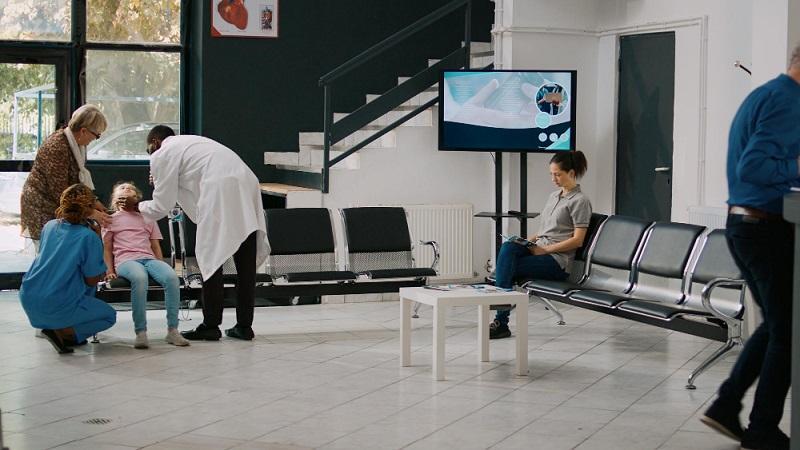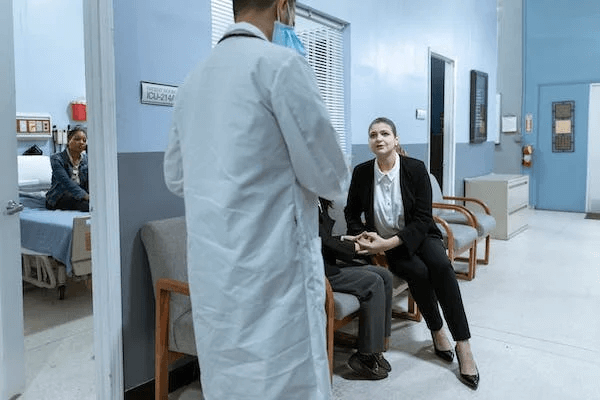A patient’s experience is not confined solely to medical procedures in the healthcare sector. It encompasses every interaction, from scheduling an appointment to post-treatment follow-ups.
This comprehensive encounter, referred to as Healthcare Customer Experience (CX), holds immense significance in shaping one’s perception of the quality of care.
Understanding Healthcare Customer Experience is crucial. It goes beyond medical expertise, encompassing empathy, accessibility, and seamless service delivery.
This article explores the various facets of Healthcare CX, examining its current state, emerging trends, and essential strategies for enhancement.
From integrating digital health tools to the evolution of telehealth services, we delve into transformative technologies redefining patient engagement.
Additionally, we dissect the different stages of the Healthcare Customer Journey, highlighting critical touchpoints for optimizing satisfaction and care outcomes.
Join us in unraveling the intricacies of Healthcare Customer Experience and discover how it forms the cornerstone of a patient-centered approach in modern healthcare delivery.
Importance Of Customer Experience in Healthcare
The significance of customer experience in healthcare cannot be overstated. It encompasses every patient interaction within the healthcare system, from scheduling appointments to receiving follow-up care.
Understanding and improving customer experience in healthcare is crucial for ensuring patients feel supported and valued. Additionally, staying updated with healthcare customer experience trends is vital in adopting innovative practices that enhance the overall quality of care.
By prioritizing customer experience in healthcare, providers can improve patient satisfaction, promote better health outcomes, and establish trust between patients and their providers.
Overview of the current state of customer experience in healthcare

The current state of customer experience in the healthcare industry is a topic of increasing importance. Despite its significance, the industry is not performing well in this regard.
- A staggering 95% of customers share negative experiences they have had with healthcare organizations. It is not uncommon for an average American to share their poor customer experience with healthcare facilities with at least 15 other people.
- Consumers are becoming increasingly aware of the importance of customer experience in healthcare. In fact, 80% of consumers believe that a company’s experience is just as important as its products and services.
- PWC’s survey “Experience is everything” found that positive experiences are most influential and significant in the healthcare industry (78%) as compared to other industries such as banking (75%), restaurants (74%), and hotels (74%).
- According to a study by Accenture, 64% of consumers would switch providers for a better overall experience. Additionally, patients with a positive experience are more likely to recommend a healthcare organization to friends and family and return for future treatments.
- In recent times, healthcare organizations have recognized the importance of customer experience and are trying to improve in this area. Many recognize the five categories that customer experience falls under: convenience, quality, support, personalization, and communication.
- Healthcare workers also make the excellent customer experience their top priority. 49% of healthcare provider executives now recognize customer experience as a top strategic priority.
- Not to mention, 81% of companies involved in healthcare are now investing in technology to improve customer experience and, by extension, healthcare success.
What Is Customer Experience in Healthcare?
Customer Experience in Healthcare refers to a patient’s overall interaction and satisfaction throughout their healthcare journey. It encompasses various touchpoints, from initial appointment booking to post-care follow-ups.
Key aspects include:
- Accessibility and Ease of Use: Ensuring patients can navigate healthcare systems effortlessly.
- Empathy and Communication: Treating patients with understanding and providing clear information.
- Efficient Service Delivery: Minimizing wait times and streamlining administrative processes.
Improving customer experience in healthcare is paramount for several reasons:
- Enhanced Patient Satisfaction: A positive experience increases patient contentment and trust.
- Better Health Outcomes: Patients are more likely to adhere to treatment plans and recommendations.
- Establishment of Trust: A positive experience fosters trust between patients and healthcare providers.
Keeping an eye on customer experience trends in healthcare and leveraging customer experience solutions is crucial for staying at the forefront of patient-centered care. This includes adopting digital tools and telehealth services and continually utilizing data-driven insights to refine the healthcare experience.
Why Is Healthcare CX Important?
 Now, you must be wondering what cx means in medical terms. In medical terms, CX stands for Customer Experience, signifying a patient’s overall encounter with healthcare services. Customer Experience Management in healthcare is pivotal for several reasons.
Now, you must be wondering what cx means in medical terms. In medical terms, CX stands for Customer Experience, signifying a patient’s overall encounter with healthcare services. Customer Experience Management in healthcare is pivotal for several reasons.
Firstly, it directly impacts patient satisfaction and perception of care quality. A positive experience promotes trust and confidence in healthcare providers. Moreover, it influences patient engagement, ensuring individuals are more likely to adhere to treatment plans and follow-up appointments.
Integrating virtual waiting rooms in healthcare is a tangible way to enhance CX. Reducing physical wait times and providing a convenient, comfortable patient environment demonstrates an organization’s commitment to their well-being.
This improves patient satisfaction and leads to more efficient use of resources and staff time.
Ultimately, prioritizing Healthcare CX is about providing medical treatment and creating a supportive, empathetic environment that fosters optimal health outcomes and patient well-being.
Current Customer Experience Trends in Healthcare
In the healthcare industry, staying attuned to the latest trends in customer experience is imperative. These trends reflect the industry’s commitment to providing optimal care and showcase innovative approaches to enhance patient satisfaction and engagement.
Let’s explore some current healthcare customer experience trends shaping how we experience and interact with medical services.
1. Mobile Apps and Patient Engagement
Mobile apps have transformed patient engagement, providing easy access to healthcare resources. Features like mobile queueing streamline check-ins, reducing wait times.
Additionally, platforms like WhatsApp for appointments offer a familiar, user-friendly interface, further enhancing accessibility and convenience in healthcare interactions. These innovations empower patients, ensuring their experience is efficient and user-centered.
2. Telehealth and Virtual Care
Telehealth and Virtual Care have revolutionized healthcare delivery. They enable remote consultations, bringing medical expertise directly to patients’ homes. Examples of customer service in healthcare via telehealth include:
- 24/7 Availability: Offering round-the-clock access to medical advice and consultations.
- Personalized Attention: Tailoring care plans and advice to individual needs.
- Follow-up Support: Providing post-consultation guidance and monitoring progress.
- Efficient Communication: Utilizing secure messaging for quick responses to patient inquiries.
- Tech Support and Training: Assisting patients in using telehealth platforms effectively.
These practices exemplify how telehealth enhances customer experience in healthcare, providing convenient, accessible, and personalized care options.
3. Digital Health Tool
Digital health tools encompass various technologies, from mobile apps to wearable devices, designed to empower individuals to manage their health. These tools facilitate easy access to information, tracking vital metrics, and revolutionizing healthcare delivery.
Additionally, self-service kiosks in healthcare have emerged as a pivotal digital health tool. These interactive stations allow patients to check in, update personal information, and access essential resources.
Self-service kiosks enhance efficiency and convenience in healthcare settings by streamlining administrative processes.
4. Patient Portals and EHR Access
Patient portals and Electronic Health Record (EHR) access revolutionize the healthcare customer experience.
They grant patients secure online access to their medical records, appointment scheduling, and communication with healthcare providers. These digital tools empower individuals, fostering a more informed and engaged patient population, ultimately leading to improved healthcare outcomes.
5. Chatbots And AI-Powered Support
Chatbots and AI-powered support are instrumental in improving customer experience in healthcare. They enhance accessibility by responding instantly to patient inquiries, scheduling appointments, and even symptom assessments.
Integrating digital signage further complements this technology, offering real-time updates and directions within healthcare facilities, creating a seamless and informative environment for patients ultimately elevating their healthcare customer experience.
How To Improve Healthcare Customer Experience?

Enhancing healthcare customer experience is a critical goal for providers and institutions alike. Implementing targeted strategies can significantly impact patient satisfaction and overall care quality.
Let’s dive into key approaches to improve the healthcare customer experience and ensure patients receive the best care.
1. Reduced Wait Times
Reducing wait times is pivotal in enhancing the healthcare customer experience. Implementing a patient queueing solution streamlines processes optimizes scheduling, and leverages technology for efficient patient flow.
By minimizing wait times, healthcare providers demonstrate respect for their patient’s time and contribute to a smoother, more satisfactory care journey.
2. Streamlined Registration and Check-In
Streamlining registration and check-in processes is crucial for a seamless healthcare customer experience. Utilizing electronic forms, pre-registration, and self-service kiosks expedites the process. This reduces waiting times and ensures accurate and up-to-date patient information, setting the foundation for effective care delivery.
3. Patient Education
Patient education is a cornerstone of customer experience in healthcare. Clear, accessible information empowers patients to understand their conditions, treatment options, and preventive measures.
Utilizing easy-to-understand language, visual aids, and educational resources fosters informed decision-making, leading to better health outcomes and a more satisfied patient population.
4. Personalized Care Plans
Crafting personalized care plans is a pivotal aspect of customer experience trends in healthcare. Tailoring treatments, therapies, and lifestyle recommendations to individual patient needs and preferences ensures a more effective and satisfying healthcare journey.
This approach demonstrates a commitment to the unique well-being of each patient, fostering trust and enhancing overall care quality.
5. Follow-up and Engagement
Establishing effective follow-up and engagement protocols is essential in the healthcare customer experience. Regular check-ins, post-treatment assessments, and open communication demonstrate ongoing care and concern for the patient’s well-being.
This proactive approach ensures treatment effectiveness and strengthens the patient-provider relationship, ultimately leading to improved outcomes and higher satisfaction levels.
6. Patient Feedback
Gathering customer feedback, also known as patient feedback in healthcare, is invaluable for improving healthcare customer experience. It provides insights into what works well and where improvements can be made.
By actively seeking and listening to customer feedback, healthcare providers can make informed decisions to enhance the quality of care and better meet the needs of their patients.
7. Staff Training
Comprehensive staff training is a cornerstone of a seamless healthcare customer experience. Ensuring healthcare professionals have the necessary skills, empathy, and communication techniques.
Well-trained staff can provide adequate care, address patient concerns, and contribute to a positive healthcare journey.
How digital solutions are changing the customer experience in the healthcare industry
Digital solutions are revolutionizing the way healthcare is delivered, and as a result, they are also changing the customer experience for patients. These solutions range from platforms that allow patients to connect with doctors remotely to electronic health record systems that make it easier for healthcare providers to access patient information.
By providing patients with more convenient and efficient care, digital solutions are improving the overall customer experience in the healthcare industry. Some examples highlight how digital solutions transform the healthcare industry and improve customer experience.
1- Teladoc: Teladoc is a telemedicine platform that allows patients to connect with doctors remotely through video or phone consultations. This digital solution improves the patient experience by making it more convenient for patients to receive medical care without needing to travel to a doctor’s office physically.
2- Zocdoc: Zocdoc is an online platform that allows patients to book appointments with healthcare providers and view ratings and reviews from other patients. This digital solution improves the patient experience by making it more convenient for patients to schedule appointments and by providing more transparency about the quality of care provided by different healthcare providers.
3- Epic EHR: Epic EHR is an electronic health record system that allows healthcare providers to access patient information quickly and easily. This digital solution improves the patient experience by reducing wait times and increasing the efficiency of care.
4- Medtronic: Medtronic provides digital health solutions; their mySentry system is a remote monitoring system for patients with epilepsy that allows healthcare providers to monitor seizures remotely. This digital solution improves the patient experience by allowing patients to receive care in the comfort of their own homes and by providing healthcare providers with real-time data to improve patient outcomes.
5- Ada Health: Ada Health is an AI-powered virtual health assistant that allows users to input symptoms and receive personalized health recommendations. This digital solution improves the patient experience by providing personalized care and making it more convenient for patients to access healthcare information.
The Different Stages of the Healthcare Customer Journey
The healthcare customer journey refers to a patient’s various stages when interacting with a healthcare organization. This can include everything from researching treatment options, scheduling appointments, receiving care, and following up with their healthcare provider.
Different stages of the customer journey can include the following.
1- Research: The customer becomes aware of a need or problem and begins researching possible healthcare providers and services.
2- Scheduling: The customer schedules an appointment with a healthcare provider.
3- Preparation: The customer prepares for the appointment by filling out paperwork or gathering medical records.
4- Consultation: The customer receives a consultation with the healthcare provider.
5- Treatment: The customer receives treatment or care from the healthcare provider.
6- Follow-up: The customer follows up with the healthcare provider for additional treatment or care.
7- Feedback: The customer provides feedback or reviews about their experience.
It’s important to note that the customer journey is not always a linear process. Customers may go back and forth between stages or even skip stages entirely.
Additionally, different customers may experience different pain points in their journey, which can alter their healthcare journey differently.
Common Pain Points in the Healthcare Customer Journey
Analyzing common pain points in the healthcare customer journey is crucial for identifying and addressing areas of improvement. By understanding where patients may experience difficulties or frustrations, healthcare organizations can take steps to enhance the patient experience.
Common Pain Points in The Healthcare Customer Journey
Alt-Text: Healthcare-staff–helping-people-navigate-the-healthcare-facility
Identifying and addressing common pain points in the healthcare customer journey is paramount for a positive patient experience. These pain points often include:
- Long Wait Times: Lengthy waits for appointments or in waiting rooms can lead to frustration and dissatisfaction.
- Communication Gaps: Patients may need to be more informed about their care, leading to disconnection and mistrust.
- Navigational Difficulties: Understanding the complexities of the healthcare system can be challenging, causing confusion and anxiety.
- Follow-Up Concerns: Inadequate post-treatment care or communication can result in certainty and satisfaction.
- Convenience Issues: Difficulty scheduling appointments, accessing medical records, or obtaining timely answers due to limited digital solutions can be frustrating.
- Lack of Personalization: Patients may feel treated as generic cases rather than individuals with unique needs.
- Physical Environment: An unpleasant, unclean, outdated healthcare facility can negatively impact the overall experience.
Implementing Digital Solutions for Healthcare
Digital solutions are revolutionizing the healthcare industry and are playing a significant role in improving the customer experience. These solutions include the use of electronic health records, online portals for patients scheduling appointments and accessing medical records, telemedicine, and mobile health apps.
One major benefit of digital solutions is that they provide patients with greater convenience and accessibility. For example, online portals allow patients to schedule appointments and access their medical records at any time, from anywhere. Telemedicine allows patients to consult with healthcare providers remotely, reducing the need for in-person visits. Mobile health apps give patients access to health information and tools that help them manage their health more effectively.
Digital solutions are changing the healthcare industry and providing patients with a more convenient, accessible, and personalized experience. They are also helping healthcare organizations to improve communication, coordination, and care. Here are some popular advances in digitizing the healthcare industry.
1- Virtual and Remote Queueing: Patients can check in and wait for their appointments remotely rather than in a physical waiting room. This can greatly reduce wait times and increase patient satisfaction.
2- Self-Check-In Kiosks: Patients can check in for their appointments independently rather than waiting in line to speak with a receptionist. This can speed up the check-in process and provide patients a more efficient and convenient experience.
3- Digital signage: This can be used to improve the customer experience in healthcare. Digital signage can include displaying wait times and important information or even providing entertainment for patients while they wait.
4- Forecasting Module: A digital solution that helps healthcare organizations predict future demand for their services. This can include things like predicting the number of appointments, emergency room visits, and the number of people who will be admitted to the hospital. By forecasting demand, healthcare organizations can better plan for staffing and resource needs, which can help them improve the customer experience.
5- Appointment Scheduling: Digital solutions such as online scheduling portals or mobile apps can help improve appointment scheduling systems. These allow patients to schedule appointments at their convenience and reduce phone or in-person wait times.
6- Patient Feedback Systems: Online surveys, for example, can also be used to gather patient feedback and improve the customer experience. This can help healthcare organizations identify areas where they need to improve and make changes to enhance the patient experience.
Leveraging Data and Analytics
Data and analytics are critical in improving customer experience in the healthcare industry. By collecting and analyzing data on patient interactions, healthcare organizations can gain valuable insights into patient needs, preferences, and pain points. This can help organizations identify areas where they need to improve and make data-driven decisions to enhance the customer experience.
Data and analytics can be used in various ways to improve customer experience in healthcare. For example, data on patient wait times can help healthcare organizations identify bottlenecks and optimize the flow of patients through the facility. Data on patient satisfaction can help organizations understand how well they meet patient needs and identify areas for improvement.
Moreover, data and analytics can also be used to track key performance indicators that are important to customer experiences, such as patient satisfaction, wait times, and patient engagement. This can give healthcare organizations a holistic view of how well they meet patient needs and help them identify areas for improvement.
Some common data sources in the healthcare industry include electronic medical records (EMRs), patient surveys, and claims data. EMRs contain a wealth of information about patients, including their medical history, treatment plans, and outcomes.
Patient surveys can provide insight into how patients feel about their care and their overall experience. Claims data can be used to track patient outcomes and measure the effectiveness of different treatments.
There are also a variety of analytics tools available to healthcare organizations. These include business intelligence (BI) tools, data visualization tools, and machine learning platforms.
BI tools can help healthcare organizations consolidate, analyze, and report on data from multiple sources. Data visualization tools allow organizations to display data in an easily understandable format, such as charts, graphs, and maps. Machine learning platforms can be used to analyze large and complex data sets to identify patterns and predict future trends.
Importance of Patient Personalization in Improving Customer Experience in the Healthcare Industry
Personalization is becoming increasingly important in the healthcare industry as it allows for a more tailored and personalized experience for patients. By using data and analytics, healthcare organizations can better understand their patient’s needs and preferences and use this information to improve the customer experience.
One of the main benefits of personalization is that it can help to improve communication and engagement between the healthcare provider and the patient. Personalization can also help to improve the efficiency and effectiveness of the healthcare delivery process by providing patients with more appropriate care.
Patient personalization is crucial in improving customer experience in the healthcare industry because it allows healthcare providers to dispense services unique to each patient’s needs and preferences.
By understanding a patient’s individual characteristics, healthcare providers can deliver more personalized and effective care. This can lead to better health outcomes, increased patient satisfaction, and improved overall customer experience.
Personalization can also help healthcare providers to more effectively communicate with patients, as they can use tailored messaging and communication channels that are most likely to resonate with the patient. Personalization helps healthcare providers better understand the patient’s needs and preferences, which can lead to more effective care planning and better outcomes.
Common Customer Experience Issues in the Healthcare Industry
The healthcare industry is complex, and providing a positive patient experience can be challenging. However, by understanding common customer experience issues, healthcare organizations can work to address and improve these areas.

Some common customer experience issues in the healthcare industry can include:
1- Long wait times – Patients often experience long wait times in waiting rooms and for appointments. This can be frustrating and lead to negative perceptions of the healthcare organization.
2- Inefficient scheduling – Scheduling appointments can be cumbersome for patients and healthcare organizations. Especially if scheduling is done manually, it can lead to frustration for patients and wasted time and resources for the healthcare organization.
3- Lack of communication – Patients may feel that they are not being kept informed about their care or treatment plans leading to their confusion, anxiety, and mistrust.
4- Inconvenient follow-up – Patients may find it difficult to schedule follow-up appointments or communicate with their healthcare providers after their initial visit. This can be due to long waiting hours on phone calls or even in-person, particularly if patients have busy schedules or transportation issues.
5- Difficulty navigating the healthcare system – Patients may find it difficult to navigate the healthcare system and understand their options for care. This can be a major source of confusion and frustration.
6- Lack of transparency: Patients may feel that they are not receiving transparent and clear information about costs, insurance coverage, and other financial aspects of healthcare.
7- Inadequate patient education: Patients may not receive adequate education about their condition, treatment options, and follow-up care, which can lead to poor understanding and poor outcomes.
8- Limited access to patient data: Patients may have limited access to their own medical data, which can make it difficult for them to understand their health status, track their progress, and make informed decisions about their care.
Final Words
When discussing the healthcare industry, prioritizing the healthcare customer experience is paramount. Organizations can significantly elevate patient satisfaction and overall care quality by addressing common pain points and implementing strategic solutions.
Customer journey mapping emerges as a powerful tool, enabling a comprehensive understanding of patient perspectives and emotions. Through this process, key touchpoints are identified, allowing for targeted improvements.
The result is a healthcare journey marked by reduced wait times, enhanced communication, and personalized care. Ultimately, this fosters trust and loyalty and leads to improved health results.
By continuously refining and optimizing the healthcare customer experience, organizations solidify their commitment to providing exceptional care.



